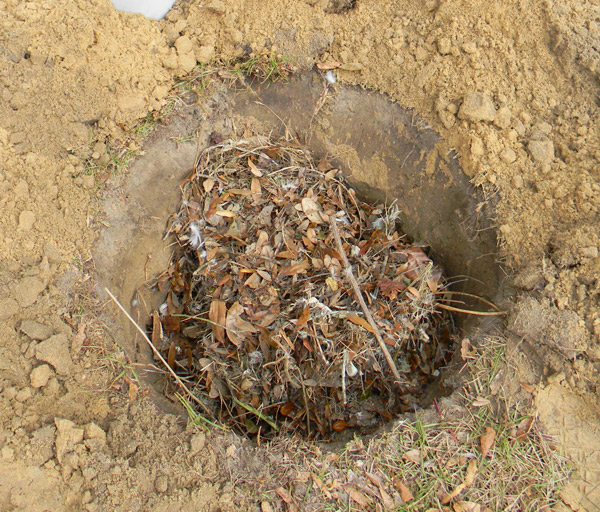Okay, so I’ve taken to calling my in-ground hugelkultur experiments “melon pits.” That’s because I’m punching these 3′ deep holes into my front yard food forest in the hopes of growing melons in them this summer.
Of course, the holes don’t stay 3′ deep. After the tough work of digging, I fill them with a mix of wood, moss, leaves, waste paper, bones, organic debris I rake from the chicken yard, raw manure, straw, biochar, etc.
Here’s my process: the first thing I did was dig a pit, then throw in some chicken-yard debris or waste paper.

Then, I dumped in sticks, pieces of logs, or, in this case, busted-up pallet wood.


 Followed by a planting with cool-season nitrogen fixers. Lentils, chick peas and fava beans.
Followed by a planting with cool-season nitrogen fixers. Lentils, chick peas and fava beans.
UPDATE: Melon pits work!
For those of you interested in this project, I’ve written a lot more about melon pits in my book Compost Everything: The Good Guide to Extreme Composting. It’s $5.99 as a Kindle edition or $14.99 in paperback – and beyond the melon pit idea, I also share a ton of other easy composting methods for using all the organic matter that comes through your household.
 Fish emulsion, redneck vermicomposting, composting toilets – oh yeah, we’re talking serious composting. Pick up a copy!
Fish emulsion, redneck vermicomposting, composting toilets – oh yeah, we’re talking serious composting. Pick up a copy!


10 comments
Fantastic :)
Yet another project to add to my list. Thanks for the inspiration! :)
If you try it, please let me know how it goes. This is all experimental right now.
Forgot to ask – lentils, chick peas, fava beans – from a seed company? or the grocery store? I wonder if they'd sprout from the store..hmm…
Grocery store. I'm a total cheapskate. The fava beans came from an Indian market.
Thanks for the reminder. Went to the grocery store tonight, came back with 2 bags of the "French bean soup mix", which has about 15 different types of beans, including lentils and garbanzos. Also bought some raw redskin peanuts, and they had a 2-for-1 deal on a variety bag of little soup potatoes, about 5 varieties. All going in the ground ASAP.
Nice. I love those bean assortments. When planted, you can't figure out what the heck kind of varieties you're growing until they get big.
Incidentally, I've been told that most commercial potatoes are sprayed with sprout inhibitors to keep them from growing eyes on the shelf. I've had decent luck despite that. One garden I did in TN was planted solely with a mix of red, white and yellow potatoes I found while dumpster diving. Heh.
My very best luck, however, has been with using organic grocery store potatoes for seed stock. I figured those weren't treated with any kind of sprout inhibitors and it seems I'm right. I got last year's blue potatoes from the organic market. Cheaper than through the mail.
Hmm… hadn't thought of that, dang it.
Don't worry about it too much. Put some potatoes on a sunny windowsill and observe their growth. If they start rapidly producing eyes, you're okay. We're talking a week or so. If they just sit there and green up and the eyes grow slowly, it's a wash.
[…] el Bueno tomó prestado ese método para huesos de melón. Un hueso de melón es tanto un método de plantación como de compostaje. La materia orgánica en […]
[…] In fact, if you grow lots of pumpkins, you may even want to compost directly in your garden beds by creating melon pits. […]
Comments are closed.